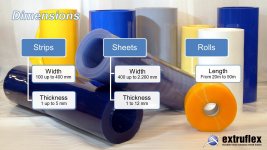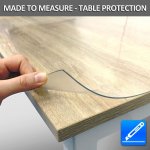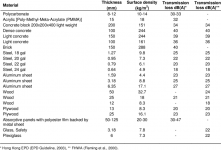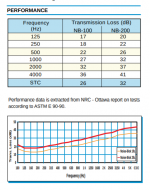Has anyone used or have any thoughts on using the kind of PVC sheeting used to protect table tops etc, to construct baffles or cabinets? It's very flexible and seems to damp/insulate sound quite well. It could be formed into smooth curves for waveguide and rounded edges to fight/use diffraction to advantage.
I've been toying with the idea of using 1/2" rubber stall mats, as it's the only exotic material I can buy within grocery shopping travel distance. The COVID uproar in the US reminds me NOT to make that extra stop...
The idea comes from a statement here where I read some people expressed disappointment after rendering their plastic cardboard prototype enclosure in wood. So maybe go in the opposite direction, where a tap on the cab side would "thud" instead of "clunk".
The stall mat material has a few practical problems;
1. It stinks. It'd have to be coated with some finish - all sides. I've no idea what would even work, nevermind what would be best. Same construction adhesive as used to glue together? Mmmm - nice cement grey over black - Wood laminate over rubber?
2. How to cut it into pieces with an accurate, clean edge? The inexpensive Craftsman table saw on a Variac better work; I doubt I could wield a knife - or jigsaw with a knife blade - along sixteen, 48 or 60" cuts and make them all perfect.
3. My local supplier only offers 24" X 48" sheets. So I was considering making the bottom foot of a 60" tall design wood, the rest of it - including where the driver mounts - out of this stall mat stuff. Or maybe it should be the other way around; top 12" wood...
4. The stuff is quite bendable, so the enclosure geometry would have to contribute to the overall structures strength and ability to "remain standing" - which sways me toward a wood footer, vs header.
Anyway, it's all a pipe dream at the moment. I'm pretty sure you can buy online at Tractor Supply and someone will toss it on the roof racks of your Subaru, so that takes the COVID exposure risk down a notch. I've yet to solve the rest to a sufficient degree to place my order.
The idea comes from a statement here where I read some people expressed disappointment after rendering their plastic cardboard prototype enclosure in wood. So maybe go in the opposite direction, where a tap on the cab side would "thud" instead of "clunk".
The stall mat material has a few practical problems;
1. It stinks. It'd have to be coated with some finish - all sides. I've no idea what would even work, nevermind what would be best. Same construction adhesive as used to glue together? Mmmm - nice cement grey over black - Wood laminate over rubber?
2. How to cut it into pieces with an accurate, clean edge? The inexpensive Craftsman table saw on a Variac better work; I doubt I could wield a knife - or jigsaw with a knife blade - along sixteen, 48 or 60" cuts and make them all perfect.
3. My local supplier only offers 24" X 48" sheets. So I was considering making the bottom foot of a 60" tall design wood, the rest of it - including where the driver mounts - out of this stall mat stuff. Or maybe it should be the other way around; top 12" wood...
4. The stuff is quite bendable, so the enclosure geometry would have to contribute to the overall structures strength and ability to "remain standing" - which sways me toward a wood footer, vs header.
Anyway, it's all a pipe dream at the moment. I'm pretty sure you can buy online at Tractor Supply and someone will toss it on the roof racks of your Subaru, so that takes the COVID exposure risk down a notch. I've yet to solve the rest to a sufficient degree to place my order.
Last edited:
The attached image shows the product referred to in your link.I don't know, would it? Flexible panel for sound optimization
It comes in rolls of different thicknesses. It is certainly flexible, but doesn't look a likely candidate for making a baffle or an enclosure!
Attachments
While such a material probably is quite good at not resonating, the problem obviously is that at low frequencies it won't be sufficiently stiff to prevent the sound the driver radiates from it's back - with reversed polarity! - from interfering (destructively) with the sound radiated at the front. Consequently the bass output will be meagre.
And at mid frequencies it also won't prevent sound from passing to the outside of the "box" nearly as much as an ordinary "wooden" material does. (Here I am talking about those ranges where the "wooden" box does NOT significantly resonate, of course.)
And at mid frequencies it also won't prevent sound from passing to the outside of the "box" nearly as much as an ordinary "wooden" material does. (Here I am talking about those ranges where the "wooden" box does NOT significantly resonate, of course.)
Well, yeah - I wouldnt make a cubic subwoofer out of the stuff.
I'm thinking more along the lines of a tapered tower with a single FR driver (OP just happened to pick "multi-way") whos geometry might assist panel vibration stiffness - versus an ordinary rectangular box with a baffle wide enough for shotgun pattern of multiple drivers.
I'm thinking more along the lines of a tapered tower with a single FR driver (OP just happened to pick "multi-way") whos geometry might assist panel vibration stiffness - versus an ordinary rectangular box with a baffle wide enough for shotgun pattern of multiple drivers.
It seems to be used quite extensively in different forms for absorption and as a barrier, I haven't been able to find any actual data yet.The attached image shows the product referred to in your link.
It comes in rolls of different thicknesses. It is certainly flexible, but doesn't look a likely candidate for making a baffle or an enclosure!
Do you know where I can find data on transmission loss?And at mid frequencies it also won't prevent sound from passing to the outside of the "box" nearly as much as an ordinary "wooden" material does. (Here I am talking about those ranges where the "wooden" box does NOT significantly resonate, of course.)
Well, yeah - I wouldnt make a cubic subwoofer out of the stuff.
I'm thinking more along the lines of a tapered tower with a single FR driver (OP just happened to pick "multi-way") whos geometry might assist panel vibration stiffness - versus an ordinary rectangular box with a baffle wide enough for shotgun pattern of multiple drivers.
Or some interesting curvy, rounded edge open baffle shape where complete acoustic opaqueness isn't such an issue?
When I first read your post, I thought of a semi-rigid PVC sheet of substantial thickness, say 25mm, which could form the walls of an enclosure or act as a self-supporting baffle.
However "PVC sheeting used to protect tabletops" looks as shown in the attachment. That, or preferably the material you linked to earlier, could be used to line the walls of an enclosure.
To be clear, which scenario are you thinking of Matt?
However "PVC sheeting used to protect tabletops" looks as shown in the attachment. That, or preferably the material you linked to earlier, could be used to line the walls of an enclosure.
To be clear, which scenario are you thinking of Matt?
Attachments
If you used the thin flexible PVC material the walls would become a highly damped passive radiator. Probably not too linear either. Each section would have different tuning, and it it impacted any bracing or the driver it would create horrible distortions. Using the rigid high density PVC board has precedent. It has the right combination of mass rigidity and damping to make practical enclosures.
For the sake of completeness, allow me to define 'Transmission Loss' (TL).Do you know where I can find data on transmission loss?
Since TL depends on material, density, thickness and frequency, finding data that directly compares the TL of different materials is proving difficult.Transmission Loss is a measurement of the dB (volume) difference on either side of a wall. Let's say we have a 100 dB tone on one side of a wall. Pretty loud. We measure this same tone on the other side of the wall and find we have 75 dB. So we would say that at this tone or pitch, we have 25 dB Transmission Loss.

Attachments
There's some data for this stuff NoiseBlok, Mass Loaded Vinyl (MLV), Noise Barrier Roll Toronto Canada
Attachments
Do you know how linear the usual materials are? I'm after something that can be easily curved or bent whilst retaining a degree of rigidity.If you used the thin flexible PVC material the walls would become a highly damped passive radiator. Probably not too linear either. Each section would have different tuning, and it it impacted any bracing or the driver it would create horrible distortions. Using the rigid high density PVC board has precedent. It has the right combination of mass rigidity and damping to make practical enclosures.
The TL of a material simply tends to rise with frequency.It would be nice to see the materials in your list at different frequencies.
- Status
- This old topic is closed. If you want to reopen this topic, contact a moderator using the "Report Post" button.
- Home
- Loudspeakers
- Multi-Way
- Flexible PVC sheet for baffle/cabinet



